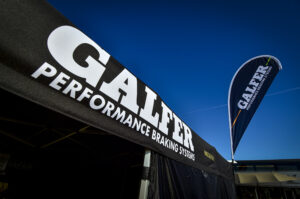DETROIT – This weekend’s CryptoDATA Motorrad Grand Prix von Osterreich – the Austrian round of the MotoGP – is one of the most challenging for the motorcycles’ brakes, according to the Brembo engineers.
The Austrian GP, set for Aug. 18-20 at the Red Bull Ring, marks the halfway point in the MotoGP championship and will be held on the same track that hosted Formula 1 at the beginning of July.
According to the Brembo technicians who work closely with all the MotoGP World Championship riders, the Austrian track is an extremely demanding circuit on the brakes. On a scale of 1 to 6, it is rated 6 on the difficulty index.
A chicane was introduced in 2022 to the layout used in Formula 1 to improve motorbike safety on Turn 2. The riders have to move from right to left which puts their skill to the test and offers new possibilities for overtaking, making the GP even more demanding on the brakes because of this additional braking section.
Brembo Greenance pads: zero compromises
According to the Environmental Performance Index, a study performed by the World Economic Forum in collaboration with the universities of Yale and Columbia and based on 32 indicators, Austria is the sixth cleanest country in the world. This is by virtue of one of the strictest air pollution and waste management standards in Europe.
Brembo is very sensitive to environmental issues as demonstrated by the new Greenance pads where the name conveys a wish to combine performance and sustainability.
These pads in the aftermarket range offer improved performance thanks to a more stable friction coefficient at high temperatures and high speeds and a 10 percent higher average friction efficient.
The Greenance pad compounds are also made with zero copper and nickel and for the type with ceramic compounds, no asbestos and antimony. Methane gas has also been eliminated from the production process which, when fully operational, will reduce CO2 emissions by 176 tons per year.
One two three four – what hard work!
MotoGP riders use their brakes eight times per lap at the Red Bull Ring, for a total 30 seconds which amounts to 34 perccent of the overall race time. It is the only GP in Europe in which the brake system is used for more than one third of the race which explains the massive stress it is subjected to, due also to the mid August heat.
The toughest braking sections are almost all concentrated on the first four corners, on each one, the motorcycles reduce their speed by at least 160 km/h (99 mph) with a top speed of 213 km/h (132.4 mph) on the first corner thanks to braking lasting at least four seconds which increases the pressure of the Brembo brake fluid by more than 11 bar.
Summing up all the forces applied by a rider on the brake lever from the starting line to the checkered flag, the result comes to over 1.2 metric tons, just slightly lower than the Qatar GP.
air-raising seconds
Of the eight braking points at the Red Bull Ring, four are classified as hard on the brakes, two are of medium difficulty and two are light.
The hardest braking section is on Turn 4 even if this is not where the top speed is reached, the MotoGPs go from 298 km/h (185 mph) to 88 km/h (54.6 mph) in six seconds during which time they cover a distance of 292 meters (958 feet) and are subjected to a deceleration of nearly 1.5G.
The load on the Brembo lever is 6 kg (13 lbs.) whereas the brake fluid pressure is 11.5 bar.








